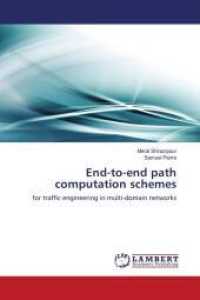- ホーム
- > 洋書
- > 英文書
- > Business / Economics
Full Description
Phytoremediation is the process that uses plants to remove pollutants from soils. These pollutants are stored in the edible parts of plants and, if they are consumed above a certain level, they become a health risk for humans and animals. This book is a critical review of phytoremediation, its direct or indirect effects on food products, and the risks posed by this cost-effective technology in food safety. It shows how different plants are suited for phytoremediation, explains the role of toxicants in the environment, and analyses their effects and risks in the food chain at a global level. It also reviews the extraction methods of toxicants from plants after they are exposed to phytoremediation.
Features:
Summarizes the phytoremediation technology for effective remediation
Describes different types of pollutants in soils that render food products useless
Identifies the role of phytoremediation in the environment and its advantages and disadvantages
Explains the role of phytoexclusion and phytostabilization in foods and food safety
Includes many case studies to describe the extraction protocols in postharvest for food safety
This book is intended for practitioners in public and private companies involved in soil remediation and food production, as well as graduate students and academics, in both developed and developing countries, who are involved in soil and environmental sciences, the food industry, agriculture, and biotechnology.
Contents
Section 1: Prospects of Phytoremediation for a Safe Environment and Safe Food. 1. Phytoremediation Overviews and Roles in Food Safety. 2. Phytoremediation and Role in Climate Change for a Safe Environment. 3. Organic and Inorganic Pollutant Uptake Mechanisms by Plants. 4. Soil Regeneration through Phytoremediation for Safe Foods. 5. Environmental Pollution: Causes, Types, Fate, Effects and Control Strategies. 6. Mechanism of Phytoremediation and Plant Uptake of Heavy Metals. Section 2: The Risks of Phytoremediation in Food Safety. 7. Danger of Contaminants in Foods through Phytoremediation. 8. Micro and Nano-plastics in Soil: Plant Uptake and Impact on Food Insecurity. 9. Environmental Pollution and How Toxic Elements Enter the Food Chain. 10. Acute and Chronic Effects of Contaminants from Food Crops. 11. Plant Uptake of Emerging Contaminants in Foods: The Extent of its Effects. 12. Impact of Contamination of Agricultural Soil on Man and the Environment. Section 3: Bringing Safe Foods Home through Phytoremediation. 13. Phytoexclusion and Phytostabilization: Protective Strategy of the Food Chain from Contamination before Phytoremediation. 14. Phytoremediation: Strategies for Protecting the Food Chain from Contamination. 15. Phytoremediation and Food Safety Case Studies. 16. Phytoremediation: A Comprehensive Review on the Prospective Benefits and Biosafety of Vegetables. 17. Soil Assessment Policies and the Permissible Level of Contaminants in Plant Food Products. 18. Plant Uptake of Emerging Contaminants in Foods: Regulatory Considerations and Future Directions. 19. Toxic Metals and Emerging Contaminants in Food: A Global Perspective.








